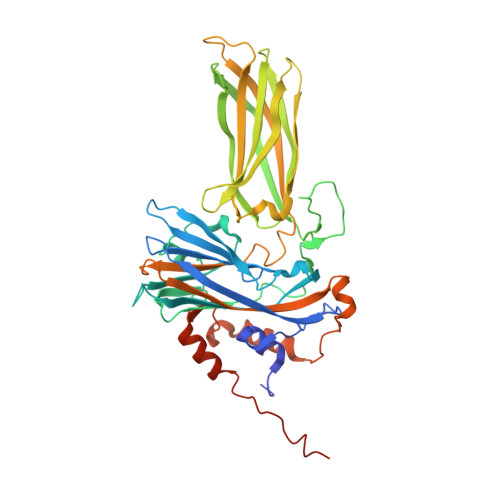Autoproteolytic Activity Derived from the Infectious Bursal Disease Virus Capsid Protein
Irigoyen, N., Garriga, D., Navarro, A., Verdaguer, N., Rodriguez, J.F., Caston, J.R.(2009) J Biol Chem 284: 8064-8072
- PubMed: 19144647
- DOI: https://doi.org/10.1074/jbc.M808942200
- Primary Citation of Related Structures:
3FBM - PubMed Abstract:
Viral capsids are envisioned as vehicles to deliver the viral genome to the host cell. They are nonetheless dynamic protective shells, as they participate in numerous processes of the virus cycle such as assembly, genome packaging, binding to receptors, and uncoating among others. In so doing, they undergo large scale conformational changes. Capsid proteins with essential enzymatic activities are being described more frequently. Here we show that the precursor (pVP2) of the capsid protein VP2 of the infectious bursal disease virus (IBDV), an avian double-stranded RNA virus, has autoproteolytic activity. The pVP2 C-terminal region is first processed by the viral protease VP4. VP2 Asp-431, lying in a flexible loop preceding the C-terminal most alpha-helix, is responsible for the endopeptidase activity that cleaves the Ala-441-Phe-442 bond to generate the mature VP2 polypeptide. The D431N substitution abrogates the endopeptidase activity without introducing a significant conformational change, as deduced from the three-dimensional structure of the mutant protein at 3.1 A resolution. Combinations of VP2 polypeptides containing mutations affecting either the cleavage or the catalytic site revealed that pVP2 proteolytic processing is the result of a monomolecular cis-cleavage reaction. The D431N mutation does not affect the assembly of the VP2 trimers that constitute the capsid building block. Although VP2 D431N trimers are capable of assembling both pentamers and hexamers, expression of a polyprotein gene harboring the D431N mutation does not result in the assembly of IBDV virus-like particles. Reverse genetics analyses demonstrate that pVP2 self-processing is essential for the assembly of an infectious IBDV progeny.
Organizational Affiliation:
Department of Molecular and Cellular Biology, Centro Nacional de Biotecnología/Consejo Superior de Investigaciones Científicas (CSIC), Cantoblanco, 28049 Madrid, Spain.















